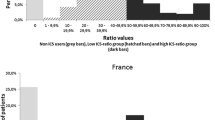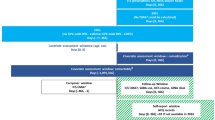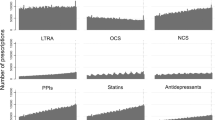Abstract
Individuals with asthma living in the inner city experience increased asthma morbidity and mortality compared to the US average. The Controlling Asthma in America’s Cities Project’s Chicago site used a multifaceted approach to improve asthma care. The diverse scope of this project’s interventions necessitated the use of novel methods to assess the effect of these interventions on the entire study area. Asthma-related medication-dispensing data were obtained from a large pharmacy chain for prescriptions filled in calendar years 2004–2006 for all individuals aged 5–17 years living in Chicago who filled at least four asthma-related medications within a 12-month period. Inhaled corticosteroid (ICS) use was considered inadequate if an individual had four or more dispensings of a short-acting beta-agonist without at least four dispensings of an ICS agent. Logistic regression was used to compare adequate ICS use in individuals within the intervention area with ICS use in the remainder of the city, after controlling for gender, insurance status, race, and poverty. A significant difference in adequate ICS use was found in years 2 (2005) and 3 (2006) of the project for individuals aged 5–9 in the intervention area (odds ratios for adequate ICS use—year 2, 1.26; CI, 1.04–1.53, p = 0.04; year 3, 1.30; CI, 1.08–1.55, p = 0.008) compared to individuals aged 5–9 in the remainder of the city. There was no similar significant difference in the 10–17 age group. These findings suggest an effect of a large multifaceted asthma intervention in improving medication use in the targeted age group. This methodology might also prove useful in the future for assessing the effect of similar interventions.


Similar content being viewed by others
Notes
From the US Census Bureau (ArcGIS version 10; ESRI; Redlands, CA, USA).
References
Naureckas ET, Thomas S. Are we closing the disparities gap? Small-area analysis of asthma in Chicago. Chest. 2007; 132(5 Suppl): 858S–865S.
Persky V, Turyk M, Piorkowski J, et al. Inner-city asthma: the role of the community. Chest. 2007; 132(5 Suppl): 831S–839S.
Pont LG, van der Werf GT, Denig P, Haaijer-Ruskamp FM. Identifying general practice patients diagnosed with asthma and their exacerbation episodes from prescribing data. Eur J Clin Pharmacol. 2002; 57(11): 819–825.
Moth G, Vedsted P, Schiotz PO. Identification of asthmatic children using prescription data and diagnosis. Eur J Clin Pharmacol. 2007; 63(6): 605–611.
Krigsman K, Nilsson JLG, Ring L. Refill adherence for patients with asthma and COPD: comparison of a pharmacy record database with manually collected repeat prescriptions. Pharmacoepidemiol Drug Saf. 2007; 16(4): 441–448.
Naureckas ET, Dukic V, Bao X, Rathouz P. Short-acting beta-agonist prescription fills as a marker for asthma morbidity. Chest. 2005; 128(2): 602–608.
Schatz M, Zeigler RS, Vollmer WM, et al. The controller-to-total asthma medication ratio is associated with patient-centered as well as utilization outcomes. Chest. 2006; 130(1): 43–50.
Horner SD. Using the Open Airways curriculum to improve self-care for third grade children with asthma. J Sch Health. 1998; 68(8): 329–333.
Bruzzese JM, Markman LB, Appel D, Webber M. An evaluation of Open Airways for Schools: using college students as instructors. J Asthma. 2001; 38(4): 337–342.
“Edging out the competition.” Drug Store News 2002 March 25. http://findarticles.com/p/articles/mi_m3374/is_4_24/ai_84237951. Accessed June 27, 2008.
Turk A. Overview of HEDIS 2000 asthma measurement. Am J Manag Care. 2000; 6: S342–S346.
National Heart, Blood, and Lung Institute. National Asthma Education and Prevention Program. Expert panel report 2: guidelines for the diagnosis and management of asthma. Bethesda, MD: National Institutes of Health; 1997. Publication No. 97-4051.
Illinois Government News Network (2007, May 26). Gov. Blagojevich applauds U.S. Congress for addressing SCHIP shortfall; Illinois to receive an estimated $181 million in additional federal SCHIP dollars. http://wwwc.illinois.gov/PressReleases/ShowPressRelease.cfm?SubjectID=1&RecNum=5999. Accessed June 27, 2008.
Donner A. An empirical study of cluster randomization. Int J Epidemiol. 1982; 11(3): 283–286.
Oesch JM, Kim H, Kieckhefer GM, Greek AA, Baydar N. Does your child have asthma? Filled prescriptions and household reporting of child asthma. J Pediatr Health Care. 2006; 20: 374–383.
Acknowledgement
This project was supported through a cooperative agreement with the Centers for Disease Control and Prevention, US Department of Health and Human Services, under program announcement 03030.
Conflict of interest
The authors have no conflict of interest to disclose.
Disclaimer
The findings and conclusions in this paper are those of the authors and do not necessarily represent the views of the Centers for Disease Control and Prevention.
Author information
Authors and Affiliations
Rights and permissions
About this article
Cite this article
Davis, S.Q., Krishnan, J.A., Lee, K. et al. Effect of a Community-Wide Asthma Intervention on Appropriate Use of Inhaled Corticosteroids. J Urban Health 88 (Suppl 1), 144–155 (2011). https://doi.org/10.1007/s11524-010-9476-y
Published:
Issue Date:
DOI: https://doi.org/10.1007/s11524-010-9476-y




